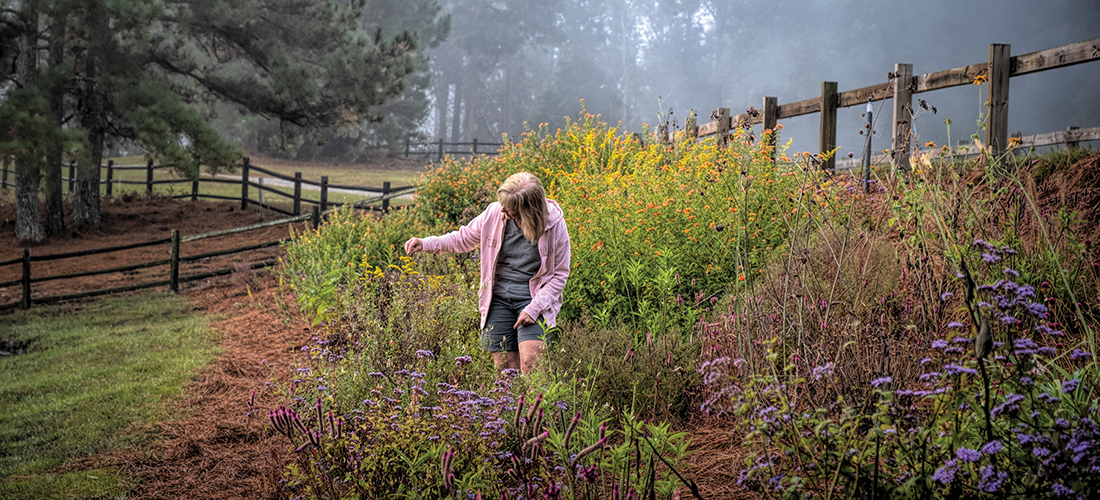
Mistletoe Farm — a sanctuary for creatures great and small
By Claudia Watson
Photographs by Laura Gingerich
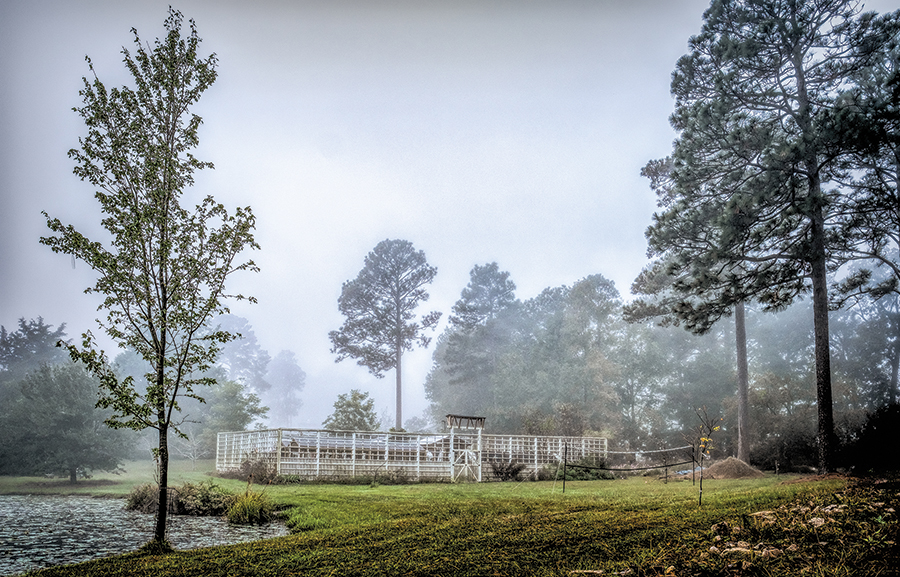
A dreamy fog lifts from the pond below, softening the profiles of the distant trees as a chorus of field crickets, grasshoppers and late summer cicadas offer a prelude to the day’s soundtrack.
It wasn’t long before we saw them, several tiny heads peering from the water on the far side of the pond. Lookouts. When her sneakers hit the dock, and they hear the call, a flotilla of three dozen pond sliders and one giant snapping turtle rush in, grabbing the fish food she tosses.
The day begins and ends with this routine at Mistletoe Farm, the 11-acre Southern Pines farm of Drs. Jeff and Lynda Acker, where even the farm’s name suggests the couple’s gentleness for all living things.
Mistletoe, Lynda’s Belgian-cross horse, was rescued from a ski resort, where she pulled a sleigh. The Ackers brought her to this farm when they relocated from Asheville.
“She was a 2,000-pound golden retriever. She’d come up behind me and lick me on the head and follow me everywhere,” Lynda recalls while tossing more food to the turtles. “We encourage everything here.”
Then, prompted by the honking of a skein of Canada geese, she points to the pasture. “There’s a straggler Muscovy duck over there, a bit of a loner. We have at least one beaver family, green and blue herons, snowy egrets, kingfishers and killdeer. Little nuthatches nest in the post,” she says, showing the spot on the dock.
Soon, her husband, Jeff, arrives, and they grapple with the rowboat set ajar. “It’s got water in the bottom from the storm. We need to drain it,” she says. Though the sun’s up and there are chores to be done, they settle instead into weathered Adirondack chairs at the pond’s edge to enjoy morning coffee together.
When Lynda isn’t busy with farm chores, she’s often tending to serene spaces for healing and restoration. Her work includes the Healing Garden at the Clara McLean House and the Hospice Gardens at FirstHealth Hospice and Palliative Care. In addition, she’s been instrumental in developing the Native Pollinator Garden at the Village Arboretum in Pinehurst, and pollinator and ornamental gardens at The O’Neal School. Now, she’s working with a team to select the plants for two healing gardens at FirstHealth’s new cancer center in Pinehurst.
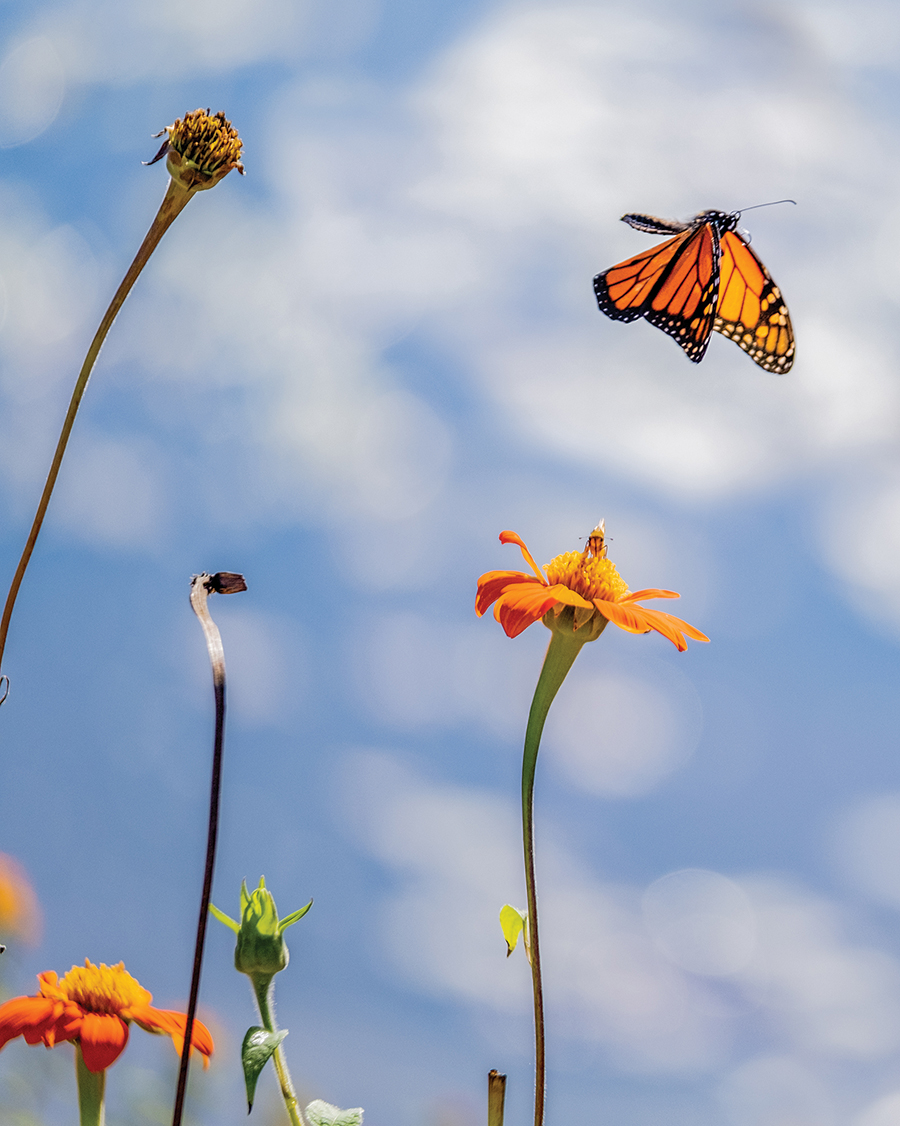
Her efforts are more than a hobbyist’s interest; she joyfully immerses herself in her endeavors. Most assume Lynda’s a botanist or etymologist because of her broad knowledge of plants and insects, specifically pollinators, but she is, at heart, a self-taught naturalist.
“I’m a biology nerd,” she says. “Sponge-like for certain topics, and my ears perk up when it’s an interesting subject.”
After obtaining a bachelor’s and master’s in biology and a Ph.D. in molecular physiology, she was awarded a MacArthur Foundation postdoctoral fellowship at Duke University. Then, she was off to the corporate world with pharmaceutical giant GlaxoSmithKline, finally founding and running a clinical documentation firm.
Though she spent years in business suits and high heels or a lab coat, Lynda says the most authentic time is when she’s out with either a shovel or fishing pole in her hand.
“My love of nature was planted, excuse the pun, very organically,” she says. Her father was a conservation officer at Chautauqua Lake, a 17-mile-long lake in western New York famous for its muskellunge (muskie), one of the largest freshwater fish native to North America. She grew up with a rescued deer fawn in their garage and a fishing pole in her hand by the age of 3. As a youngster, she ice-fished in huts on the lake with her father, along with “a bunch of Swedish men eating pickled herring and telling stories.” She had her muskie tags at 8 and, to this day, loves pickled herring.
But it’s always been the curiosities of nature that captured her attention. “I’d line up buckets in the backyard and monitor live experiments with minnows and mosquitoes,” she recalls. Her first job featured worms.
“At night, I’d go out with my white cat, Zucchini, and a flashlight to pull nightcrawlers out of the ground. I’d get two cents apiece, and Dad would steer all the fisherman my way,” she says. “I had a big box full and loved to watch them crawl.”
She also spent hours exploring the fields around their home in Chautauqua, often tunneling through the tall grasses, observing insects, then matting down a spot in the cool grass to sit, think and dream about someday going head-first into nature.
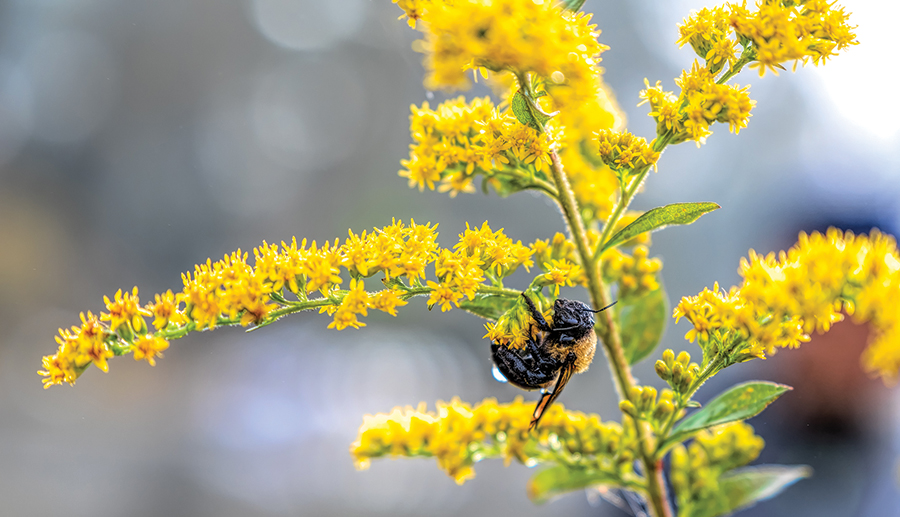
The Ackers return to Chautauqua often and spend several weeks there during the summer. Now, Lynda is a lecturer on native gardens, monarch butterflies and pollinators at Chautauqua Institution, a nonprofit education center.
Like an alarm clock, when the sun’s rays hit the beehive, warming it, the honeybees fly. At every turn, there’s a delight. Vividly colored flowers provide nectar for the native bees and honeybees. Plump red raspberries cling to their canes, begging to drop into your mouth. And a single, peachy pink “Lady Ashe” rose, given to Lynda by the Healing Garden’s original rosarian, Bill Shore, joyfully opens to the sun.
The quiet is broken by Lynda’s high-pitched call, “Come on, chickees.” A parade of eager chickens, including Prairie Bluebells, Asian Blacks, Silkies and hefty Brahma hens, emerge from all corners. The chickens’ clucking oddly melds with the soft rock music coming from a rusty radio strapped to the fence.
“It keeps the raccoons away and helps calm the chickens,” she explains while sprinkling dried mealworms as a treat for the chickens. “The beach music on Sunday mornings is their favorite.”
The chicken enclosure and multiple hoop houses are wrapped with hardware cloth to protect them from predators. Netting stretches across the top. It keeps the hawks away from the chickens but lets the songbirds and pollinators inside. Snakes are another issue.
“They freak me,” says Lynda, wincing as she turns to husband Jeff, a radiation oncologist affiliated with Moore Regional Hospital. He handles the oft-required repairs to the enclosure and deals with predator issues, among other tasks.
“We have a lot of black snakes. When the egg count dwindles, I’ll search for it and relocate it to the other side of the pond,” he says. “Of course, it’ll find its way back.”
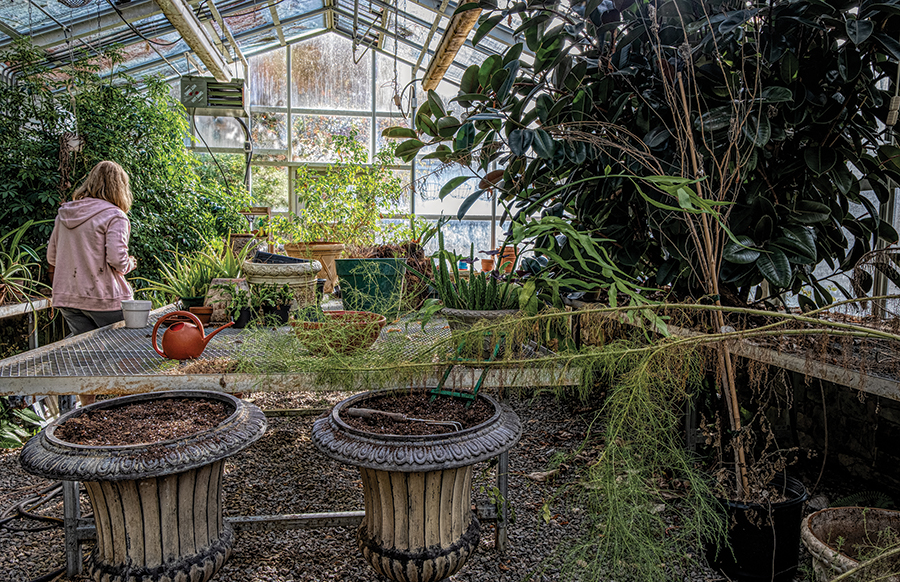
A tasty abundance fills the vegetable and fruit hoop houses. Tomatoes, peppers, garlic, root vegetables, beans, 20 types of herbs, and a beautiful row of celery fill the space. Organic parsley is everywhere and covered in eastern swallowtail caterpillars that favor it. It’s planted in the hoop houses to protect the caterpillars from the chickens.
“Oh, there’s an egg,” exclaims Lynda with delight, pointing to a tiny white ball on the top of a leaf. Evidence of the butterfly’s visit.
Dozens of southern highbush (Vaccinium formosum) and rabbiteye blueberry bushes (Vaccinium virgatum) flourish in two blueberry houses. When the berries ripen, walk-by grazing is encouraged.
Later, Lynda’s up on a ladder, attaching stiff mesh Japanese fruit bags to protect clusters of Concord grapes, other varieties of bunching grapes, and the regional favorite, muscadines. Though she prefers Concords, they don’t do well in our climate.
“The Chautauqua Lake area is home to Welch’s grape juice and jam. I grew up on the Concord grapes grown in the region, and they remain my favorite. The grapes in these bags are the good ones for our table,” she says. “The chickens and mockingbirds get the rest.”
Fig trees complete the garden. Both a single Brown Turkey (Ficus carica ‘Brown Turkey’) and two Celeste (Ficus carica ‘Celeste’) trees provide a sweet snack. Unfortunately, not for her.
“My bees eat them before I can,” she says while warily picking one. “Once they crack open, you don’t want to pick it. The honeybees will be in it.” Figs, she explains, are a food source for bees, and the sweet fruit significantly pumps up the bees’ honey yields.
It’s a short walk up the hill where an elegant lanceleaf Japanese maple (Acer palmatum var. dissectum) graces the entry to the iron and glass greenhouse. When the Ackers built the greenhouse, they, like most, wanted a place where they could grow plants that wouldn’t normally grow here and also to extend their growing season.
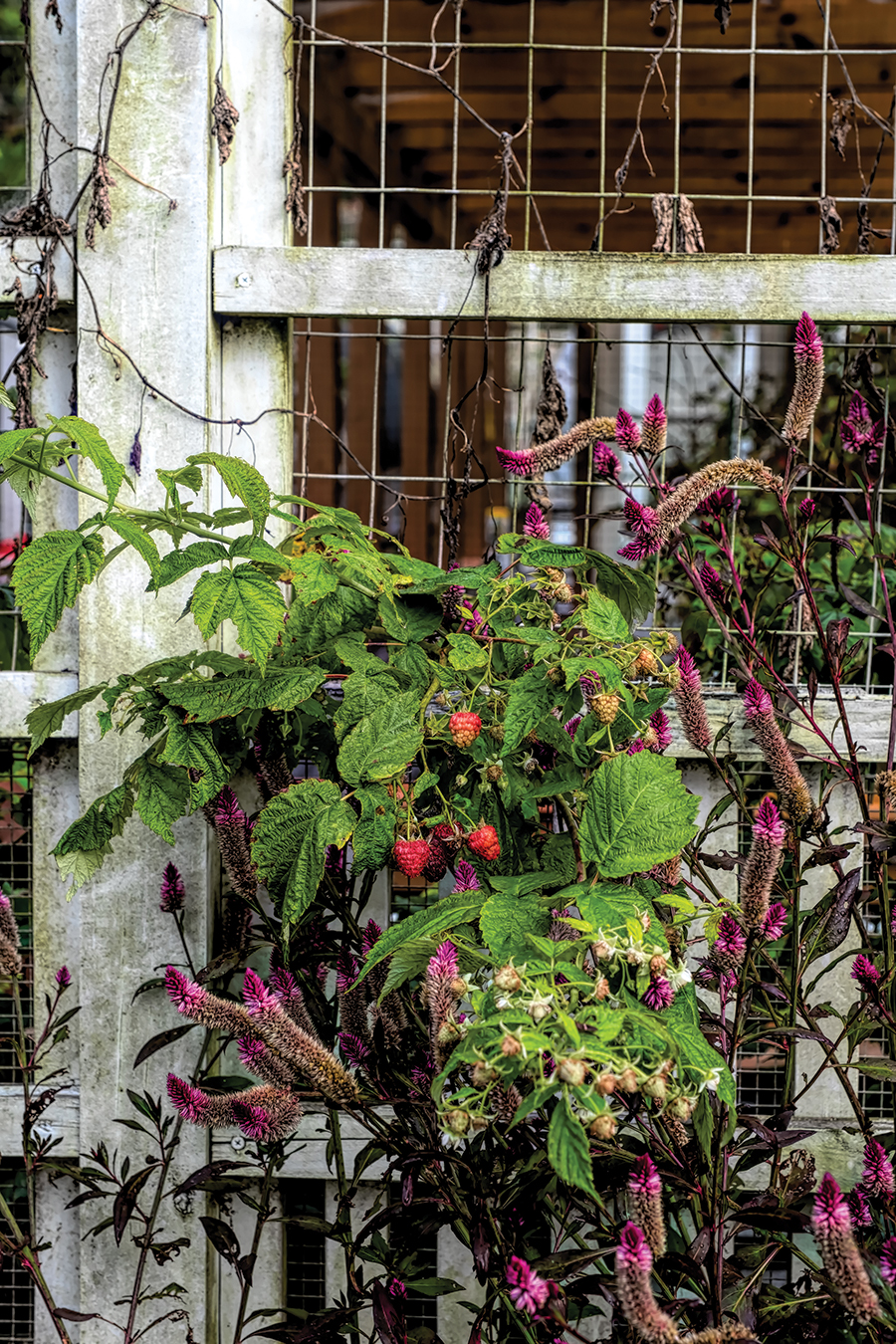
For many years, it was a hub of activity. Boston ferns overwintered. They adopted massive staghorn ferns (Platycerium spp.) from friends who migrated here from Florida. An enormous schefflera made this home after starting life as a bonsai in Hawaii. And that rubber tree?
“It was a houseplant, and for some reason, it ended up in here,” explains Lynda as she looks up through the plant’s canopy, which touches the greenhouse’s ceiling. “It grew through the table and took root in the ground. We’ve cut it back several times, but it owns the place now.”
When the greenhouse was humming, Lynda added praying mantises and green lacewings to the mix to keep the pest insects down. “I’d find baby praying mantises everywhere, and it was so magical,” she recalls.
Today, the greenhouse gives the couple a quiet place to repot plants over the winter months. “There are days I’ll come out here for a dose of sunshine and peace,” says Lynda, who found it a haven during the pandemic. “I don’t know what I’d do without nature. It makes me tick. It’s always been the underpinning of my life.”
The climate in the greenhouse is perfect for Jeff to start hundreds of milkweed seedlings each winter. Most seedlings are destined for the Village Heritage Foundation’s annual spring plant sale to benefit the Native Pollinator Garden.
But the pièce de resistance is the monarch waystation habitat.
The waystation provides food and habitat for the struggling monarch butterfly population. Unfortunately, the monarch and other pollinators, like native bees and honeybees, are in a stunning decline. Scientists say it’s due to the loss of the insects’ habitat, the increased use of pesticides and herbicides, and environmental change.
Jeff’s domain is the waystation, located on the steep slope of the dam at the edge of the big pond. “I handle the planting, weeding and maintenance of this area. We don’t use any herbicides or pesticides, so it’s all done the old-fashioned way, by hand,” he says. “Planting is a process, and there aren’t shortcuts.” His shovel hits the hard ground with a thwack. “It’s solid clay, so every time I plant, I dig a big hole and fill it with good dirt. That’s why there’s a big compost pile over there.”
Though a layer of pine straw helps hold the soil moisture and keeps the weeds down, the recent addition of irrigation gives young plants a better chance to get established. “It’s also very welcome, since Jeff spent many a late afternoon roasting in nearly 100-degree heat watering the area,” adds Lynda.
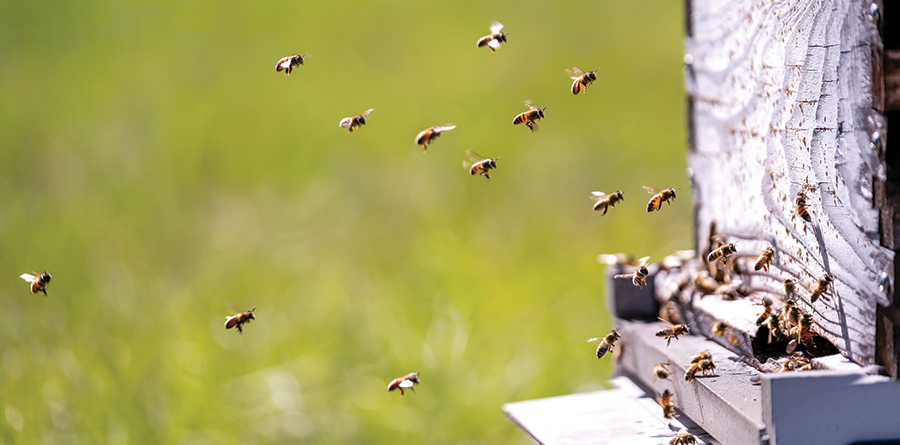
The Ackers’ goal is to keep planting nectar plants and milkweed. Milkweed is the only plant on which monarchs lay their eggs, and their caterpillars feed. Last year, unfortunately, the Ackers ran out.
“Toward the end of the season, we had so many caterpillars that we had to leave many of them on the plants,” explains Jeff. If hand-raised, monarchs’ survival rate is likely to reach 80-95 percent, far exceeding the meager 2-10 percent of monarchs that survive to become butterflies in the wild.
They’ve had spotty results with common milkweed (Asclepias syriaca), the plant most people associate with the word “milkweed.” It blooms from late April until mid-May, which is suitable for the first generation of monarchs, those offspring of monarchs from Mexico hatched in the south and migrating north to lay eggs.
“The milkweed is finally getting established and running,” he says. It spreads by underground rhizomes and is better suited for large fields and pastures. Plus, the butterflies don’t favor it when there’s butterfly weed nearby.
“Butterfly weed (Asclepias tuberosa) stays small, and it will self-seed an area, so it is great in the garden,” he says. It’s also the variety he raises from seed each winter.
Showy pink swamp milkweed (Asclepias incarnata) prefers mucky or very moist soil, so they’ve planted it near the water’s edge.
In addition, there are many other types of host and nectar plants to attract a wide range of pollinator species. Some favorites include dog-toothed daisy (Helenium autumale), which puts on quite a show in late August. The heat and drought-tolerant lanceleaf coreopsis (Coreopsis lanceolata) brings a big splash of yellow. And the sweet vanilla scent of Joe-pye weed (Eutrochium purpureum) is irresistible to pollinators.
Dragonflies prefer the long-blooming purple coneflower (Echinacea purpurea) and spiky prairie blazing star (Liatris spicata) for landing sites. Ohio spiderwort (Tradescantia ohiensis) and boneset (Eupatorium perfoliatum) attract native bees.
Lynda also plants the seeds of the fluffy-plumed purple celosia (Celosia argentea), which grows tall and needs the support of the fence near the hoop houses. Delicate, poppy-like windflowers, commonly called anemones, and a bed of colorful mixed coreopsis sway in the breeze, attracting different species. But Lynda’s favorite is the brightly colored Mexican sunflower (Tithonia rotundifolia). Though it’s non-native, it’s striking and non-invasive. Its orange, zinnia-type flower is the “hands-down best bee and butterfly magnet,” she says. But it’s gangly, growing 4-to-6-feet, so best suited for the back of a border.
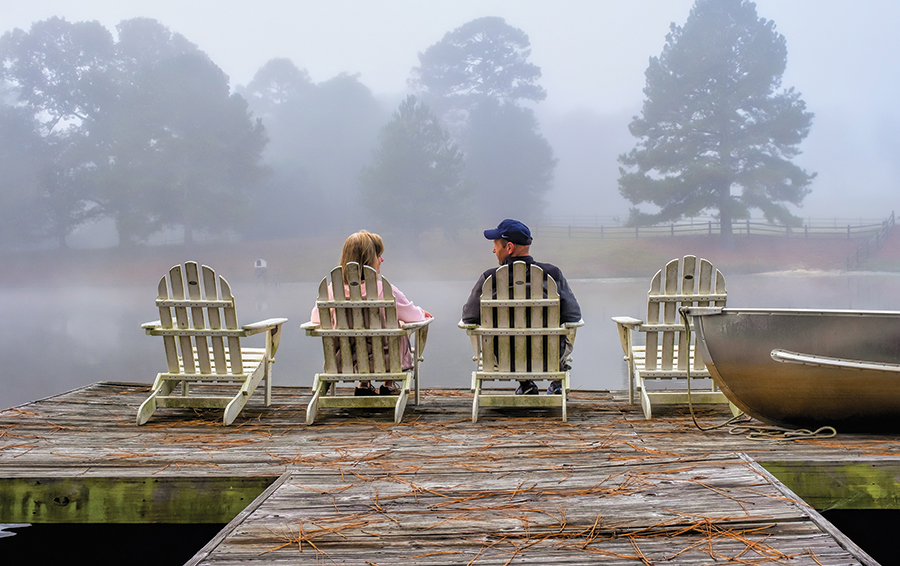
Mistletoe Farm is a living laboratory. Lynda’s excitement for nature is contagious, and before you know it, you’re walking softly and looking at the details.
“Oh, look,” she says and points. “Here’s a native bee asleep on the goldenrod (Solidago rugosa ‘Fireworks’). It has a drop of dew on it — they are so tiny and beautiful. There are over 4,000 types of native bees. About half are in serious trouble, and many are extinct. Since all are solitary, there is not a hive to go back to, so they curl up, like this little guy, and sleep on a plant.”
Lynda explains that native bees often lay their eggs in tunnels they make in riverbanks, barren slopes, a root ball or the edge of a forest. “Those are the places people often tag as unsightly, and it is bye-bye bee habitat. Or they see a bee and spray it,” she says.
“Over there is a gorgeous dragonfly, and all the little skippers flitting around, and a moth — all so beautiful. It just makes me nuts when I see someone spraying pesticides. Look at what they’re missing. What are they thinking? Oh, I saw a bug I don’t like, so let’s kill everything.”
Lynda encourages everyone to visit a waystation for a rich learning experience. Then, plant one.
“It can be a small garden planted with some milkweed and nectar plants. Or plant fields of it. It all helps the monarchs on their journey north then back again to overwinter in Mexico,” she says. “Pollinator gardens in our backyards, parks and school gardens will help end habitat fragmentation and the loss of our pollinators. Then, we’ll have a far more viable and vibrant natural community.”
Lynda readily admits she enjoys seeing visitors in the area’s pollinator gardens.
“When I see them with their grandchildren, and they are pointing out the native plants and pollinators by name, it’s so gratifying,” she says. “They’re passing along the knowledge to our future generations, and those generations are our best hope for our planet.”
Mistletoe Farm feeds the senses with its extraordinary and complex beauty. It is not just a meadow, a pond, a vegetable garden or a waystation, but the sum of the whole — a sanctuary for all creatures, great and small.” PS
Claudia Watson is a regular contributor to PineStraw and The Pilot. If there’s a garden that you’d like her to visit, email cwatson87@nc.rr.com.





